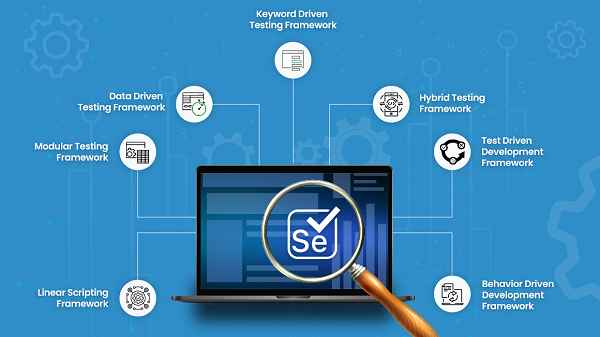Selenium Testing is a widely used automated testing framework that is available for free as an open-source tool. It enables the validation of web applications across various platforms and browsers. Selenium Test Scripts can be created using multiple programming languages such as Java, C#, Python, and more. The process of conducting tests with Selenium is commonly known as Selenium Testing.
The other widely adopted approach for testing web applications is to utilize automated software. This approach offers several advantages, including time and cost savings for companies as well as more accurate results compared to manual testing. One of the most popular automated software frameworks used for web application testing is the Selenium Framework. Let’s delve into the Selenium Framework and its key characteristics.
What is the Selenium Framework?
The Selenium Framework is an extensive suite of automation testing tools that are built using the JavaScript framework. Selenium executes tests directly on the desired web browser. This means that you can run your tests on popular browsers such as Chrome, Firefox, Safari, and Internet Explorer, among others.
By running tests directly on the target browser, Selenium enables you to accurately simulate user interactions on specific web pages, including clicking buttons, filling forms, navigating links, and more. This level of control allows you to thoroughly test the functionality and behavior of your web application.
Selenium can rerun tests without any manual intervention. Once you have defined your tests, you can save them and rerun them as needed, either on-demand or as part of an automated testing process. This eliminates the need for repetitive manual testing, saving valuable time and effort for testers and developers.
The Selenium Framework is designed to align with the principles of Agile and DevOps methodologies. It fits seamlessly into the continuous delivery workflow by allowing tests to be integrated into the development process and executed alongside the software build. This integration promotes faster feedback loops, enables early bug detection, and facilitates faster release cycles.
Selenium WebDriver

Selenium WebDriver, also referred to as Selenium 2.0, is a comprehensive suite of language-specific bindings that facilitate the automation of web browsers. It serves as an advanced version of Selenium Remote Control and encompasses several key components, including an API, Library, Driver, and Framework, which collaborate harmoniously to enable the execution of tests.
The API acts as a bridge between scripts written in various scripting languages and Selenium’s built-in language called Selenese. The Driver, an executable module, is responsible for launching the browser instance and executing the test script. Depending on the specific browser being used, the Driver may be tailored to its requirements, such as Chromedriver for Google Chrome.
To ensure seamless integration between WebDriver’s client and the browser/driver, testing frameworks like Cucumber and TestNG come into play. These frameworks facilitate the connection and enable comprehensive testing. Additionally, by leveraging Selenium Grid, these tests can be performed across multiple drivers simultaneously.
Selenium IDE
Selenium IDE, available as a plugin for Chrome and Firefox, is a powerful tool that records and logs natural interactions performed in the browser. It generates code snippets in various programming languages, such as Java, Python, Ruby, C#, and Selenese.
Within the IDE, testers can effortlessly record test scenarios and subsequently execute them in the browser. The IDE can replay these recorded actions and promptly highlight any code errors in red, providing valuable insights for debugging purposes.
For more precise debugging, test developers can set breakpoints at specific points in the test cases, allowing for step-by-step analysis and troubleshooting.
In Selenium IDE, multiple locators can be utilized for each element, increasing the chances of successful execution and enhancing test reliability.
Selenium IDE proves particularly useful for regression testing, where it can be utilized for quickly prototyping and identifying errors. While the generated code may not always be the most readable, this tool remains highly valuable. For comprehensive cross-browser testing, it is recommended to combine Selenium IDE with Selenium WebDriver, leveraging the latter’s capabilities for efficient and reliable testing across various browsers.
Selenium Grid
Selenium Grid offers a robust solution for executing multiple test sessions concurrently by leveraging its unique Hub and Node Architecture. By utilizing this architecture, Selenium Grid empowers users to run tests on multiple servers simultaneously, facilitating the efficient distribution of workload and accelerating the overall testing process.
In essence, Selenium Grid can be regarded as an enhanced iteration of Selenium Remote Control, taking its capabilities to a higher level. With Selenium Grid, the scope of parallel testing expands significantly, enabling the seamless operation of numerous servers in parallel. This scalability proves particularly valuable for large-scale test automation efforts or scenarios where quick and extensive testing is required.
LambdaTest is a cloud-based digital experience testing platform that allows you to perform Selenium Testing on cloud Grid that facilitates comprehensive automated testing, allowing users to verify their applications on over 3000+ real browsers, operating systems, and devices. By leveraging a scalable infrastructure, users can expand their test coverage and reduce build times, resulting in enhanced application quality and dependability.
Types of Selenium Framework

Selenium frameworks can be categorized into three main types based on the functional approach:
Data-Driven Framework:
The data-driven framework utilizes external files, such as Excel sheets, to store various data sets. These data sets are imported into the automation testing tool, allowing the test framework to fetch the required input dynamically. By keeping the data sets separate from the script, it becomes easier to modify the test script without affecting the data sets. This approach enables testers to conduct tests with multiple data sets efficiently, eliminating the need to modify each code individually.
Keyword-Driven Framework:
The keyword-driven framework focuses on using keywords as the foundation of functionality. It involves writing separate keywords to represent specific operations or methods. These keywords, stored in an external file (such as an Excel sheet), are called within the code. This abstraction of complexity simplifies the code and allows testers to modify each functionality individually without affecting others. By utilizing keywords, this framework enhances code reusability and maintainability.
Hybrid Framework:
The hybrid-driven framework combines elements of both the data-driven and keyword-driven frameworks. It utilizes separate files to store inputs, functions, and keywords. Similar to the data-driven approach, it enables the use of the same code for different data sets. Additionally, it leverages the keyword-driven approach to abstract the complexity of the code and enhance code organization. This hybrid approach offers flexibility and versatility in test execution, making it suitable for various testing scenarios.
By choosing the appropriate framework based on the specific requirements of your project, you can optimize the efficiency and effectiveness of your Selenium automation testing.
Why Choose Selenium Framework for Automated Browser Testing?

After familiarizing ourselves with the components and tools provided by Selenium, let’s explore the key benefits and reasons why Selenium is an excellent choice for automation testing:
- Open Source: Selenium is an open-source framework, which means it is freely available for download and usage. Unlike many other automation tools, Selenium does not require any licensing fees, making it a cost-effective option.
- Emulation of User Actions: Selenium WebDriver allows for the emulation of user interactions, enabling the automation of various real-life scenarios. It can simulate key presses, mouse clicks, drag and drop actions, click and hold operations, selection processes, and more.
- Easy Implementation: Selenium WebDriver is renowned for its user-friendly nature. Being an open-source tool, users can develop extensions and customize it according to their specific requirements.
- Versatility for Different Scenarios: Selenium is a suite of tools, providing options that cater to diverse testing scenarios and work methodologies. Regardless of your specific needs, you are likely to find a suitable tool within the Selenium ecosystem.
- Language Support: Selenium offers comprehensive support for major programming languages, including Java, JavaScript, Python, Ruby, C#, Perl, .NET, and PHP. This versatility empowers developers with the freedom and flexibility to choose the language they are most comfortable with.
- Browser, Operating System & Device Compatibility: Selenium is compatible with a wide range of browsers, such as Chrome, Firefox, Opera, Internet Explorer, Edge, and Safari. It also supports various operating systems (Windows, Linux, Mac). This compatibility ensures comprehensive test coverage across different platforms.
- Framework Support: Selenium seamlessly integrates with popular frameworks like Maven, JUnit, and TestNG, simplifying the automation process. It also supports continuous integration and deployment tools like Jenkins, enabling automation throughout the entire development lifecycle.
- Reusability: WebDriver scripts are designed to be cross-browser compatible, allowing testers to execute multiple test scenarios using a single code base. This reusability feature enhances efficiency and reduces maintenance efforts.
- Community Support: Selenium benefits from an active and supportive community. The availability of vast information resources and a helpful community makes it easier to seek guidance and find solutions to challenges when needed.
- Advanced User Input: Selenium’s WebDriver enables advanced user input, including requesting clicks on browser back and front buttons. This functionality proves especially useful when testing applications involving actions like money transfers. Such advanced features are not commonly found in many tools, particularly open-source alternatives.
Conclusion
In today’s technology landscape, the demand for efficient and reliable testing across various browsers and devices is crucial to ensure compatibility and deliver a seamless user experience. In this regard, Selenium automation testing stands out as the preferred choice. The Selenium Framework has gained widespread adoption across industries due to its numerous advantages, including feasibility, flexibility, and cost-effectiveness, which set it apart from other testing frameworks.
One of the key benefits of Selenium is its feasibility. The framework provides a comprehensive set of tools and libraries that enable testers to automate web applications effectively. Its support for multiple programming languages, such as Java, Python, and C#, allows teams to leverage their existing skills and expertise, making it accessible to a wide range of developers and testers. Additionally, Selenium’s extensive documentation and active community contribute to its feasibility by providing valuable resources and support to users.
Read also:
- Mistakes That You Need to Avoid When Selling Online Courses
- wmlink/2step Setup: Walmart One 2 Step Verification Process, Registration, Login
- How to Play NCAA 14 on PS4
- How to Activate BET+ Plus on Apple TV, Roku, Amazon Fire TV
- NYC CityTime Login Page at a826-ra.dep.nyc.gov
- Mousocoreworker.Exe Preventing Sleep On Windows
- How to Login UKG Pro Account 2023 UltiPro UKG Login
- Tips for Effective Labeling and Barcoding of Warehouse Inventory



